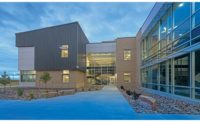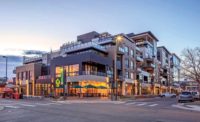Despite coming off a challenging year, design and engineering firms across the region are rebounding with a level of work not seen since before the Great Recession.
The American Institute of Architects reported in April that the Architecture Billings Index recorded its third consecutive month of positive billings, with scores for both new project inquiries and new design contracts strengthening to 66.9 and 55.7, respectively (any score above 50 indicates an increase in billings).
“This recent acceleration in the demand for design services demonstrates that both consumers and businesses are feeling much more confident about the economic outlook,” Kermit Baker, AIA chief economist, said in a statement.
This energy, which Baker says is fueled in part by pent-up demand for new and retrofitted facilities, is touching nearly every aspect of the industry. At the same time, firms are working to keep up with a demand for both labor and materials and adjusting to a new way of doing business that’s not-so-usual.
|
Related Link |
Optimistic Outlook
At the beginning of the pandemic, firms paused briefly to figure out how to reconfigure their workplaces. Most bounced back strong, with a combination of work from home and office, leaning into the virtual and remote environment, says Josh Gould, a senior vice president at Stantec.
“The affordable and market-rate housing sectors haven’t missed a beat, and as employees are returning to their offices, people are finding it a good time to step up to Class A or Class B space or to downsize. Leases always expire,” he says.
Gould says federal work, including projects for the GSA and national parks, along with local civil and municipal projects, are also on the rise as these entities have begun to receive stimulus funds.
Designers also are seeing an uptick in sustainability consulting as corporations have begun to take environmental concerns much more seriously and are moving their facilities toward carbon-neutral and high-performance designs.
“We see signs of improvement in transportation, water and specific vertical building markets. We’re feeling pretty optimistic,” says Alan Eckman, vice president of business development for AECOM. “An incredible amount of discussion is happening about infrastructure at the national, state and local levels. Multiple bills in the Colorado legislature are aimed at transportation funding, and this is great news for road and bridge projects as well as for opportunities in the transit area.”
Mark Lichtwardt, senior vice president and general manager of Burns & McDonnell’s Denver office, says his firm is seeing tremendous growth in the foods manufacturing market—not just in the Mountain States but also across the country. And while data center projects were strong pre-pandemic, “that market literally exploded with everyone going home and becoming virtual,” he says, noting that the growth of remote work impacts water, power, fiberoptic design and other related markets as well.
Rachael Johnson, AIA Colorado president and an architect with SmithGroup, says health care work has come back twofold after being paused while hospitals focused on COVID-19. “Now they have money to spend and are more confident in their capital projects that were on hold while they dealt with the pandemic.
“Higher ed has not died down either,” she says. “Capital is flowing into Colorado, and firms are taking advantage of school being out during summer.”

EFFICIENCY: Burns & McDonnell partnered with Garney Construction on the Plum Creek Water Purification Facility in Castle Rock, Colo.
Image courtesy of Burns & McDonnell
Keeping Up With Demand
Housing and water projects are booming throughout the Mountain West, especially in Colorado, Utah and Idaho, with both sectors being driven by population growth, aging infrastructure and drought conditions.
“Salt Lake City currently has a shortage of 50,000 housing units,” says Phil Haderlie, AIA Utah president and a principal with VCBO Architecture. Haderlie speculates that as people spent the past year working from home, they also chose to leave more expensive parts of the country, creating the current housing scarcity and sky-high pricing.
But the building boom has resulted in a shortage of construction materials and rising costs that have made projects less feasible, and “it’s catching everyone off guard,” Johnson says.
As a result, firms are thinking about how to adjust their designs—for instance, being more proactive about materials selection and pricing forecasts. “How do we keep up with our schedule if wood is 10 times what it should be because all of the factories shut down [during the pandemic]?” she says. “We’re upstream of that and our projects are downstream; we’re caught balancing both. Supply and demand are out of whack.”
Materials aren’t the only scarce resource in this post-pandemic era. Firms are transitioning their people back into the office full time, and many are struggling to find architects qualified to do the work.
“We’re having a great year, but getting employees is difficult,” says Larry Weis, a vice president with Electrical Consultants Inc. in Billings, Mont. “We do solar development and need to put people in the field to manage those projects; we need that skill craft right now, and we’re very short on talent. And on the electrical engineering side, retaining engineers is always a challenge.”
Tim Haener, president and CEO of J-U-B Engineers, says that while the demand for work is increasing economy-wide, the supply of engineers and technical professionals is not keeping up. “In a booming economy, a lot of construction jobs are available for kids who might otherwise go to college for engineering or another technical degree,” he says. “The pandemic has exacerbated the issue, [with] many choosing to delay college, which may further worsen the labor supply going forward.”
The New Normal
“In order to understand the workforce of the future, we’re investing in cloud-based technology and calibrating our real estate cost to adjust for employees not wanting to come back full time,” says AECOM’s Eckman.
When social distancing became the norm, design firms shifted to virtual bid walks, something that Burns & McDonnell’s Lichtwardt thinks will continue, even with 20%-25% of the firm’s employees back in the office.
“One huge positive coming out of the pandemic will be how we communicate. Some of our clients embraced technology before, but now more, if not everyone, is moving to a cloud-based format. While the best solution is to meet face to face, having a 15-minute video call will be a huge benefit to our industry,” he says.
Haener agrees. “COVID has accelerated the ability to communicate and work at a distance, and our plan is to embrace that when there is a true win-win with our employees, J-U-B and the client. Otherwise, we’re planning for folks to come back into the office because, especially for younger people, that camaraderie and teamwork is so important.”
“We don’t really know what the new normal will be coming out of the pandemic,” Lichtwardt adds. “Will people be remote, in person, hybrid? How will our clients embrace technology? We’re trying to assess this, adapt and stay on the forefront of technology going forward.”





Post a comment to this article
Report Abusive Comment